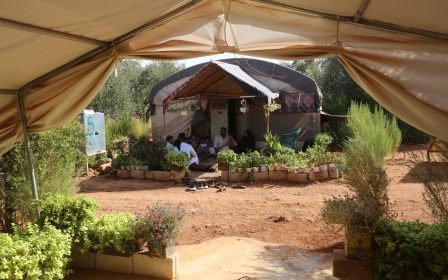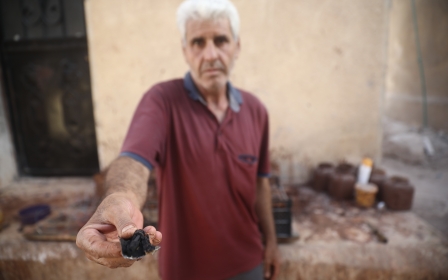In pictures: Young Idlib artist painting for peace
Thirteen-year-old Usama al-Ali is one of approximately 500 children living in Camp al-Anwar, north of the Syrian city of Idlib. Displaced by an ongoing conflict entering its 10th year, many of the children will have few memories of their life before displacement. For Usama, who was only four when the Syrian uprising and subsequent war broke out, it’s in the camp that he found his true calling. (All pictures by Muhammad Al Hosse)
"The situation we’ve been living in over the past three years or more made me start learning to paint,” says Usama. “At first I was painting tents and things all around us in the camp as well as the effects of the war.” With prices for essential items soaring in war-torn Syria, artist supplies such as brushes, paints and canvas are a luxury. To save on the cost of paint, Ali found that a cheaper option was to grind up chalk he bought at a local stationary shop and mix it with some dye to create different colours.
When his father, Saleh al-Ali, noticed his son pick up an interest in painting three years ago, he decided to help nurture this budding talent. “I encouraged him to paint the things that we are going through in the camp and in the country,” says Saleh, an Arabic teacher who himself has a love of art. Because of the father’s background training in Arabic, he was able to help his son with Arabic calligraphy, which his son was also fond of.
“I had a love for art when I was young but my family didn’t support me,” says Saleh. “When I saw that Usama had the same passion and talent, I wanted to give him my full support.” On weekdays, Usama attends a school outside the camp 7km away in Maarrat Misrin, which he walks to.
Usama’s family fled their home in the village of Abu Thahur in the Idlib countryside three years ago, after their home had been destroyed by government shelling. He and his parents and 12 siblings fled the village with relatives by car, and headed straight to the camp. “My first feelings were somewhere between fear and terror … painting helped me to relax," says Usama.
In several of his paintings, scenes of destruction and hope are displayed side by side, offering an insight into Usama’s life as a child living in a warzone. On the left of the image above, a village burns under the writing, “Agh! Oh, homeland!” On the right reads, “Oh homeland, we are returning!”
While a number of Usama’s paintings inevitably feature symbols of the war that haunt him, such as mines and bombed fields, he also paints portraits, caricatures and more natural scenes. It was his first artwork, of a horse sipping from a watering hole, that he painted on the back of the door of his nightstand, which first made his father take notice of his talents.
In recent months, Usama has also been creating banners and paintings focussing on the coronavirus pandemic and its impact on the locals living in the camp. “An ounce of prevention is better than a pound of cure!” reads the sign he has painted on the side of his family’s tent, part of which he uses as a dedicated art studio.
Although there have been reports of people with flu-like symptoms, to date there have no confirmed Covid-19 cases in the camp, where sanitation facilities are limited. Not having access to medical masks, Usama started painting face masks on to the children’s faces as a way to both have fun and raise awareness of the dangers. “I started painting face masks to encourage the children to wear them,” Usama says. “Some of us kids got together and made a couple masks by hand from old clothes. Other people in the camp nicknamed my tent ‘the tent of wonders’ because everything comes out of it.”
Usama also paints other images of the world around him and in his imagination, including underwater life and an abstract rendering of the four seasons. Even though supplies are scarce, Usama's father has high hopes for his son to become a professional artist one day. In the meantime, his father fashioned Usama an easel with scraps of used wood found in the local market. “Sometimes I use some of the household funds to support my son with the small things he needs,” says his father.
In the meantime, Usama teaches the other children in the camp, and especially those wounded in the war, everything he’s learned about art so far. And he continues to paint and exhibit his work to the people around the camp and others who come to see it from further afield. “[I want to] be able to have an exhibition in Syria. I hope to have an exhibition abroad, too,” Usama says, adding that he hopes to have enough money one day to support his family and teach art to children for free.
In this painting, a child is seen walking across the back of a man who is lying on his front on the floor like a bridge. The image, Usama says, expresses the way his own father helped him pursue his passion as an artist “despite the dark times we are living in the future”.
Middle East Eye delivers independent and unrivalled coverage and analysis of the Middle East, North Africa and beyond. To learn more about republishing this content and the associated fees, please fill out this form. More about MEE can be found here.




